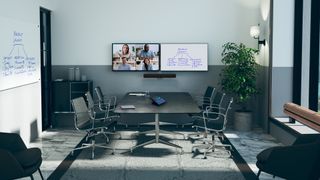According to McKinsey’s American Opportunity Survey, 58% of Americans, or 92 million people, report having the opportunity to work from home at least one day a week. Equally striking, 35% say they have the option to work remotely five days a week.
Naturally, the COVID-19 pandemic played a role in this monumental shift to a hybrid style of employment, and it’s taken root as today’s preferred model both by employees and their employers. “Choosing to work whenever and wherever one prefers—at home, the office or an off-site location gives people a greater sense of autonomy, which ultimately leads to greater employee satisfaction, well-being, productivity, and trust,” says Aurangzeb Khan, senior vice president of Intelligent Vision Systems at Jabra.
Along with these benefits, however, come challenges as the hybrid workforce and their employers begin to recognize limitations in common unified communication solutions. Technologies like PCs with built-in microphones and speakers may have sufficed at the beginning of the hybrid boom, but now end-users and employers need technology that supports a more natural, fluid form of communication.
A survey by Virtira Consulting shows that 49% of professionals working remotely are mentally exhausted as a direct result of numerous daily video calls. Today’s technology simply isn’t keeping pace. Users are struggling to hear the conversation and see the participants during meetings. “Only when virtual interaction feels natural and fluid can we achieve a normal sense of human connection that today’s hybrid workforce needs to stay engaged, enthused, and follow every part of the conversation, regardless of where they are or whether they’re at home, in a huddle space, or sitting among others at a conference table,” says Khan.

“Technology that ensures more inclusive and productive meetings is imperative to the future success of a hybrid office model,” he continues. In 2023, multi-camera systems that capture a natural, realistic view of an entire conference room, huddle space, or other collaboration area will overtake the single wide-angle camera solutions that present a distorted view of the office environment. Nobody, even those seated at the end of a table, is left out of the video and everyone looks clear, sharp, and in focus.
Equipped with artificial intelligence, the cameras integrated into a self-contained collaboration system shift focus automatically depending on who’s currently speaking, giving them more “pixel real estate—an important aspect of hybrid collaboration,” Khan says. “The movement is fluid, smooth, and makes those working remotely feel as if they’re in the same conference room with everyone else, giving them all important meeting equity. Everyone feels like an equal participant and they glean a greater physical sense of the meeting space. Rather than feeling apart from the group they feel like an important contributor.”
Likewise, new hybrid collaboration solutions must support a higher quality of audio. Just as better video requires multiple cameras, better audio communication requires multiple microphones, advanced processing and AI, all integrated into the same self-contained system. This ensures that all voices are heard, inflections are captured, audio cues are recognized and conversations flow smoothly and with background noise eliminated. “When audio and video are addressed properly through a higher-quality, more intelligent, standalone collaboration system, trust and respect across an organization increase,” Khan continues. “Corporations and their employees thrive under these conditions; it’s imperative for companies to adopt modes of hybrid collaboration.”
The continual progression of AV quality in hybrid collaboration systems will also drive changes in the layout and design of work spaces. No longer will the size and structure of meeting rooms be constrained by the limitations of the collaboration technology. When cameras and microphones are responsive to the fluidity and spontaneity of normal conversations, collaboration can occur in a host of different office environments. It all leads to a new era of virtual collaboration where every employee has a seat at the table, despite their current location. They can maintain their autonomy while still feeling an important part of the team.
Learn more about Jabra’s PanaCast video solutions that enable stronger hybrid collaboration at https://www.jabra.com/business/video-conferencing.
About Jabra
Jabra is a world leading brand in audio, video, and collaboration solutions – engineered to empower consumers and businesses. Proudly part of the GN Group, we are committed to letting people hear more, do more, and be more than they ever thought possible. Jabra engineering excellence leads the way, building on 150 years of pioneering work within GN. This allows us to create integrated tools for contact centers, offices, and collaboration that help professionals work more productively from anywhere; and true wireless headphones and earbuds that let consumers better enjoy calls, music, and media. www.jabra.com
